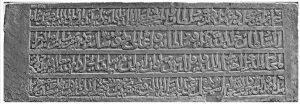
Chanderi Stone of ‘Alā’ al-Dīn Khaljī, recording the completion of a mosque in Chanderi during the governorship of Amīr al-Umarā’, Ikhtiyār al-Dawla wa al-Dīn Tamur Sulṭānī by Ismā‘īl, son of ‘Abd al-Salām, entitled Wajīh-i Najīb, the muḥarrir of the district (khiṭṭa) of Kol (Aligarh) during the reign of ‘Alā’ al-Dunyā wa al-Dīn Abu al-Muẓaffar Muḥammad Shāh (i.e. ‘Alā’ al-Dīn Khaljī, popularly known as Alauddin Khalji, d. 1316 AD).
TRANSLATION: [line 1] The construction of this mosque (took place) in the reign of the kingdom of the magnificent Sulṯān ‘Alāu’d-Dunyā wa’d-Dīn (lit. Glory of the state and religion), Iskandar (i.e. Alexander) of the Time, Abu’l-Muẕaffar Muḥammad Shāh, [line 2] The Sulṯān, may Allāh perpetuate his kingdom and sovereignty, and elevate his affairs and position, and in the time of the deputy-ship (ni yābat) of Amīru’l-Umarā (lit. the chief among the chiefs), [line 3] The refuge of the great, Ikhtiyāru’d-Daulat wa’d-Dīn, the champion (pahlvān) of Irān, Tamur Sulṯānī, may Allāh perpetuate his glories and increase his fortune! [line 4] The creature, hopeful of (attaining) the mercy in the House of Peace (namely), Ismā’īl, son of ‘Abdu’s-Salām, called Wajīh-i-Najīb, the muḥarrir attached to the District (Khiṯṯa) of Kol, completed it (on) the twentieth of the month of Sha‘bān, year (A.H.) eleven and seven hundred (20 Sha‘bān, 711=1 January 1312).